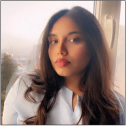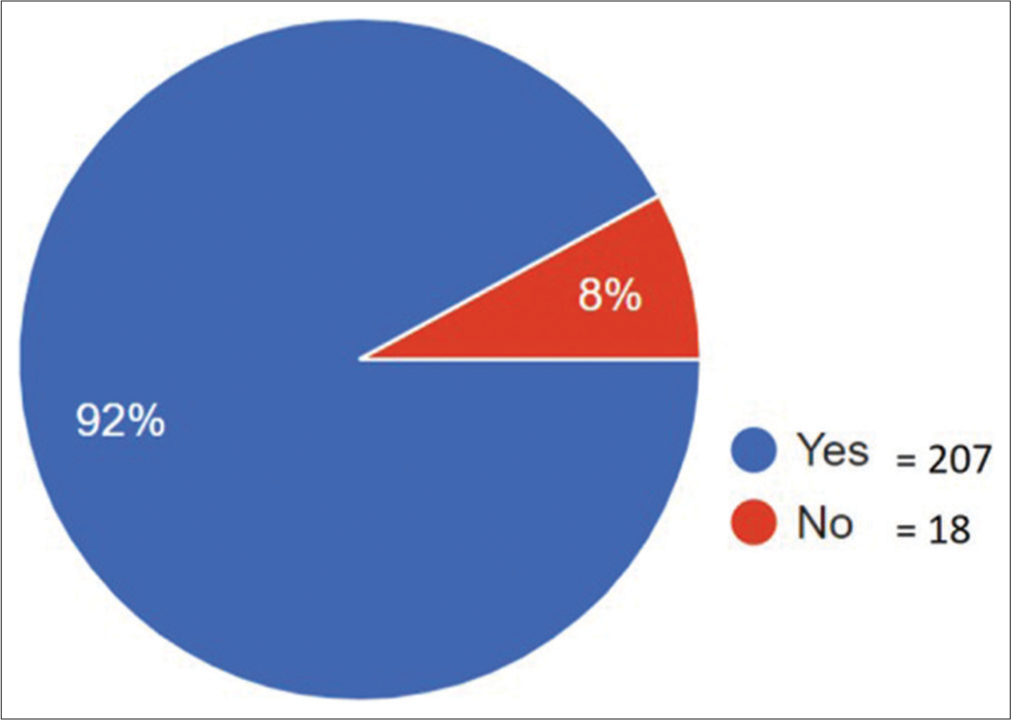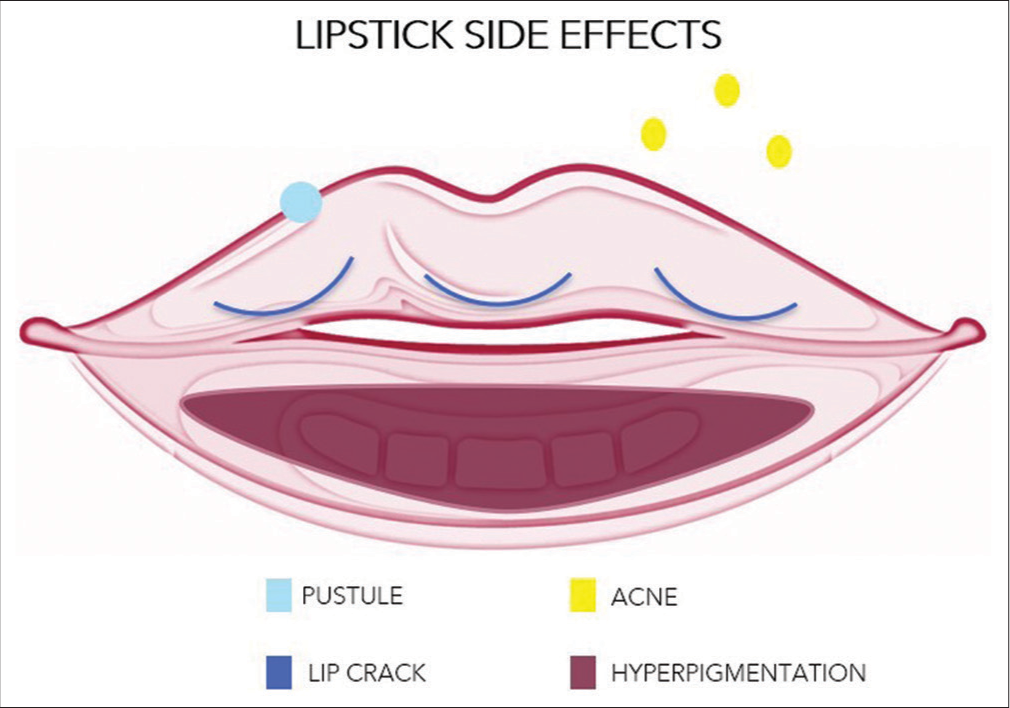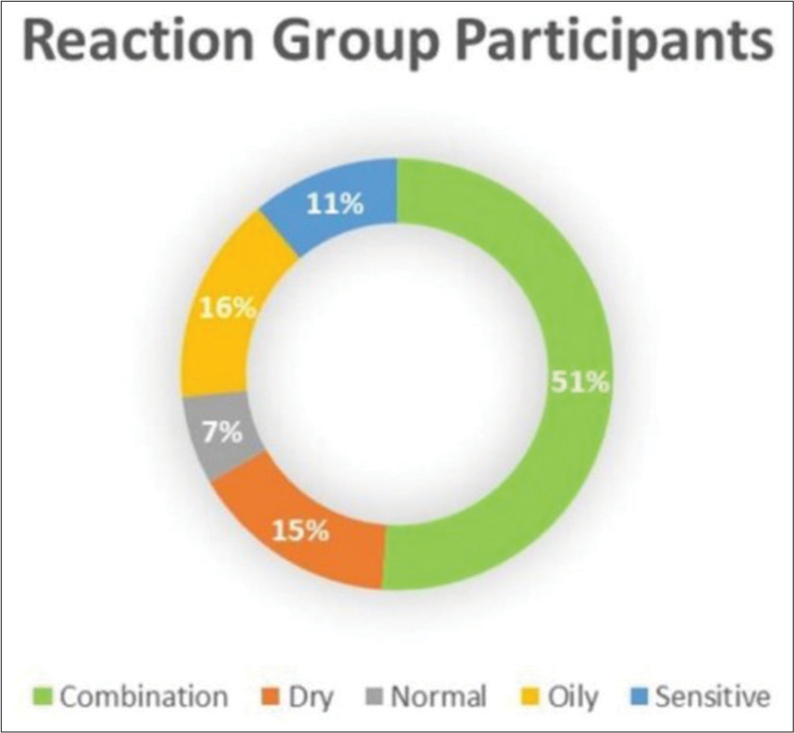Translate this page into:
Women and lipstick. Friends or foe? A cross-sectional study on lipstick side effects

*Corresponding author: Rowyna Reji Koshy, Department of Medicine, Faculty of Medicine, Tbilisi State Medical University, Tbilisi, Georgia. rowkoshy@gmail.com
-
Received: ,
Accepted: ,
How to cite this article: Koshy R, Maliyil B, Karawita JA, Selvakumar N, Fathimathul Harshiba H, Korrapati N, et al. Women and lipstick. Friends or foe? A cross-sectional study on lipstick side effects. CosmoDerma 2023;3:157.
Abstract
Objectives:
Cosmetics, especially lipstick, are essential to many people. These products can cause adverse reactions, and lips being susceptible may react more strongly. Knowing consumer reactions is essential for creating lip-friendly and safer lipsticks. The aim of the study was to evaluate the adverse impacts of lipstick use to create awareness of producing lipsticks to satisfy customers’ desires for healthy, happy lips.
Material and Methods:
We conducted a 10-day online survey using social media platforms. This social media survey helped us collect 226 responses from 21 countries. The questionnaire inquired about demographics, lipstick usage, and adverse reactions. Using Excel sheets, Chi-square test, and percentage calculation, we analyzed and filtered participant’s responses to obtain results.
Results:
Most respondents were female (94.22%), with the highest responses from India (42.22%). Among the female participants, 43.48% reported experiencing skin reactions to lipstick, whereas no reactions were reported by male participants or those identifying as “other.” The age group most prone to skin reactions was 15–25 (77.78%). According to the survey report, participants with pre-existing allergies were more likely to experience adverse reactions to lipstick.
Conclusion:
Lipstick’s widespread use raises concerns about the skin reactions it poses. Our study found hyperpigmentation, lip cracks, dryness, and burning as common reactions. For safety reasons, cosmetic companies must adhere to manufacturing laws and standards. Hence, it is essential to educate the public and seek dermatologist assistance.
Keywords
Lipstick use
Side effects
Hyperpigmentation
Lip products
Skin changes
Cosmetics
Cosmetology
Consumer safety
INTRODUCTION
Lipstick use has recently increased, resulting in mass production all over the world, and this industry is estimated to be worth billions of dollars, with the global lipstick market expected to reach $13.4 billion by 2024.[1] They have gone through an evolution in their composition and presentation throughout their rich history: from pigmented brick in ancient Mesopotamia, then to be made from animal fat and beeswax in 1869 France, all the way to synthetic and natural lipsticks being made into a plethora of shades in different formulas, composed with castor oil, paraffin, wax, beetroot juice, and lanolin.[2] Lipstick is being produced in hundreds of different color tones to satisfy the growing demand.[1,3] However, its popularity comes with a downside: its adverse skin reactions.[4]
In recent years, there has been growing concern over the potential harm that lipsticks can cause.[4] With the composition of lipstick with synthetic chemicals such as lead and phthalates, its regular usage has been linked with dry, chapped lips, reaching cancer.[4] Allergic contact dermatitis in response to lipstick ingredients and their use has been reported.[5,6] If used frequently, synthetic lipstick colors can have adverse outcomes ranging from skin discoloration to cancer.[7] Therefore, it is crucial for cosmetic dermatologists to educate their patients about the potential adverse effects of lipsticks and to recommend safe and effective alternatives.
This cross-sectional study proceeds to explore a pivotal factor that would provide more clarification to all cosmetic dermatologists regarding the skin reactions occurring due to lipstick use.
MATERIAL AND METHODS
Google Forms were used to survey individuals who applied lipstick between April 02 and April 11, 2023. The survey was available to complete for individuals for everyone who used lipstick. Participation was voluntary and anonymous. Social media networks were used to share the survey for the participants to take part in it. Informed consent was provided by each participant before completing the survey. The nonconsensual responses and responses of individuals who did not use lipsticks were eliminated before analysis.
Participants completed a 32-question survey that included consensual participation, demographic information, lipstick use, and additional questions about the presence, duration, and management of adverse reactions associated with lipstick. Survey questions involved skin type, skin care, and types of lipstick bought and used, whereas lipstick information also included the frequency and duration of their use, type of reactions occurring from using lipsticks, duration of the reactions as well as demographic information, including gender, age, and geographic location of residence, was also collected. The survey explored participants checking the expiry date and cleansing regimen that they used.
During this process, we consulted a dermatologist to review the survey questions and to provide their perspective on awareness about rising issues due to lipstick usage. We collected the data from this survey to calculate the percentage and also used Chi-square test to provide results regarding reactions in correlation with lipstick application.
Statistical analysis
Correlations between the lipstick application duration, preexisting allergies, prone skin type, and more with respect to skin reactions were assessed by filtering, analyzing, and producing statistical percentages of the data from the Excel sheets of our survey. We also used Chi-square test to get correlation aspect of results.
RESULTS
General information
A total of 226 responses were obtained from 21 countries, and few among them was discarded as one response was non-consensual and (n = 18) some did not use lipstick. The sample size of this study is small as this is a pilot study and we did not find any similar studies on this subject [Figure 1]. Maximum responses were obtained from India 42.22% (n = 95). In total, 94.22% (n = 212) of female participants, 5.33% (n = 12) of male participants, and 0.44% (n = 1) of persons with the label “other” voluntarily completed the survey. It was observed that 92% (n = 207 [studied population]) of participants used lipstick were female participants, among them about 43.48% (n = 90) had skin reactions in response to lipstick. The age group that was seen to have the highest skin reactions in response to lipstick usage was 15–25 years old with 77.78% (n = 70). Concerning pre-existing allergies, 32.22% (n = 29) had them out of the total people who had reactions. Since this is an observational study, we based the results on the information we received from the survey and did not consider any exclusion criteria.

- Participants using lipstick.
Clinical manifestations
Out of all reaction group participants, about 54.44% (n = 49) experienced hyperpigmentation, 38.89% (n = 35) experienced lip cracks, 30% (n = 27) experienced dryness, 8.89% (n = 8) experienced burning sensation, 8.89% (n = 8) experienced pustule, 6.67% (n = 6) experienced itching, 3.33% (n = 3) experienced rash only in combination skin type, and 2.22% (n = 2) experienced swelling only in normal and combination skin types following lipstick use [Figure 2]. These reactions were seen in all types of lipsticks and were not limited to one brand.

- Skin reactions caused due to lipstick wear.
The maximum response we received for each symptom based on duration is, 16.67% (n = 15) had hyperpigmentation lasting more than a week, 11.11% (n = 10) had lip crack lasting more than a day, 12.22% (n = 11) had dryness lasting a day, 3.33% (n = 3) had burning sensation lasting a day or more than a day, 5.56% (n = 5) had pustule lasting more than a day, 3.33% (n = 3) had rash for more than a day, and 2.22% (n = 2) had swelling for a few hours to more than a day. 38.89% (n = 35) felt that weather affected the adverse reaction they faced among which around 18.89% (n = 17) combination skin selected this option.
When asked about previous reactions to other makeup products, it was found that 56.67% (n = 51) had reactions to blush, eyeliner, foundation, compact powder, and other skin products, out of which foundation had the highest 26.67% (n = 24).
Lipstick information
In this survey study, we analyzed the data about lipstick texture, quality, color, and price about the skin reactions that were caused due to this product. In context to these skin reactions, 48.89% (n = 44) were seen to commonly use drug store brands, whereas 42.22% (n = 38) used high-end brands, 3.33% (n = 3) used organic brands, 1.11% (n = 1) used cruelty-free brands, and 2.22% (n = 2) were seen to use both high-end and drugstore brands. When asked about the type of lipstick that was often used by the participants who were affected, it was seen that 24.44% (n = 22) used only matte, 8.89% (n = 8) used only liquid, 7.78% (n = 7) used only creamy, 7.78% (n = 7) used only glossy, and different combinations of these were used by 51.11% (n = 46). About 18.89% (n = 17) used red shade, 14.44% (n = 13) used pink shade, and 11.11% (n = 10) used nude shade causing a reaction in the participants, whereas 55.56% (n = 50) used none of the mentioned shades. With respect to clinical manifestation seen above, since hyperpigmentation was the most common, we correlated it with the type of lipstick used and found the following results: 26.25% used liquid, 25.78% used matte, 22.89% used creamy, 19.35% used glossy, and 16.67% used metallic composition which resulted in hyperpigmentation.
Regarding lipstick application with respect to reaction in participants, 80% (n = 72) applied lipstick 1–2 times a day, whereas 6.67% (n = 6) applied it 2–4 times a day, 2.22% (n = 2) applied it more than 4 times a day, 4.44% (n = 4) applied it 1–2 times a week, 2.22% (n = 2) applied it occasionally, and timings other than these were marked by about 4.44%(n = 4) [Table 1].
| Duration of Lipstick Application | Total | Incidence | |||
|---|---|---|---|---|---|
| Reaction | No Reaction | ||||
| n | % | n | % | ||
| 1 – 2 times a day | 158 | 72 | 45.5 | 86 | 54.4 |
| 2 – 4 times a day | 12 | 6 | 50 | 6 | 50 |
| More than 4 times a day | 3 | 2 | 66.6 | 1 | 33.3 |
| 1 – 2 times a week | 5 | 4 | 80 | 1 | 20 |
| Occasionally | 15 | 2 | 13.3 | 13 | 86.6 |
Skin type
The participants were asked to choose their skin type based on their personal experience as well as prior dermatologist consultation. Among the total participants who use lipstick, 50.24% (n = 104) have combination skin, 19.81% (n = 41) have dry skin, 11.11% (n = 23) have oily skin, 8.21% (n = 17) have normal skin, and 10.63% (n = 22) have sensitive skin type. The comparison between the occurrence of skin reactions to each skin type was assessed which provided us with the following information – 51.11% (n = 46) reactions in combination skin which was the highest, whereas 15.56% (n = 14) reactions were seen in dry skin, 6.67% (n = 6) in normal skin, 15.56% (n = 14) in oily skin, and 11.11% (n = 10) in sensitive skin [Figure 3]. Hyperpigmentation was the most common reaction seen in combination, dry, normal, and oily skin. Lip crack, pustules, and dryness were the common manifestations that were noticed in sensitive skin. Although the majority had no existing medical condition, 20% (n = 8) had polycystic ovarian syndrome, skin diseases, diabetes, and anemia.

- Number of participants using lipsticks.
Skin management
Although dermatologic consultation is important, it was seen that only 12.22% (n = 11) of participants consulted with a dermatologist, whereas 87.78% (n = 79) did not consult a dermatologist for their skin manifestations [Figure 4]. The most common recommendation that was given was applying direct topical agents to ease the irritation of the patients (n = 6) and few mentioned using steroid creams (n = 2). 18.18% (n = 2) of participants were suggested patch tests by the dermatologist. However, there were 5.06% (n = 4) of participants who did a self-patch test on their skin before applying the product on their face.

- Skin management methods.
Home remedies are the most preferred choice even before going to a dermatologist for most participants. Hence, about 20.25% (n = 16) of participants who did not consult a dermatologist used home remedies which were applying beetroot juice, butter, coconut oil, curd, carrot mix, homemade lip scrub, honey, ice cubes, and Vaseline to soothe cracks and reduce irritation.
Cleansing regimen
Skin care routines were also evaluated in individuals who had skin manifestations. The majority of the participants reported that they removed makeup every day which was about 76.67% (n = 69). 18.89% (n = 17) individuals removed their makeup sometimes and 4.44% (n = 4) did not take off their makeup daily. Although predominantly participants religiously do remove their makeup, we still see an occurrence of adverse reactions in them.
We compared cleansing regimens in two groups – those who had reactions (reaction group) and those who did not have any reactions (non-reaction group). Commonly used cleansing agents in both groups were facial cleansers with 34.19% (n = 40) in the non-reaction group and 32.22% (n = 29) in the reaction group. The composition of skin care agents used by the participants might have caused an irritation due to potential allergens present in them. However, the other agents used in the reaction group were 27.78% (n = 25) micellar water, 17.78% (n = 16) only water, 7.78% (n = 7) oil, 6.67% (n = 6) cleansing toner, 6.67% (n = 6) makeup removal wipes, and 1.11% (n = 1) lip scrub. We investigated the correlation between skin care chemical agents and occurrence of reaction using Chi-square test which resulted in P-value to be 0.543 which shows that there is no significant correlation [Table 2]. Conclusions about whether using a face cleanser has led to a decrease in skin reactions are uncertain.
| Skincare Agents | Reaction Group | Non Reaction Group |
|---|---|---|
| Facial Cleanser | 29 | 40 |
| Cleansing Toner | 6 | 4 |
| Micellar Water | 25 | 23 |
| Make-up Wipes | 6 | 9 |
DISCUSSION
Cosmetics provide a global service by maintaining hygiene and enhancing the appearance of people across the world.[2] A frequently used cosmetic, lipstick may have positive social, psychological, and therapeutic effects.[8] They possess multiple disadvantages that are often overlooked but are usually embraced by women to highlight their femininity and allure. Conventional lipstick formulations may contain dangerous ingredients, resulting in allergic reactions and health issues. In addition, it has been identified that the chemicals in lipsticks cannot be eliminated or disposed of by wastewater treatment systems, which could cause environmental damage.[9,10]
A significant number of lipsticks contain ingredients in their base, pigmentation, and fragrance formulation could be extremely toxic to the body. In particular, Bisphenol A, which is found in lipstick packaging, has been related to cancer and infertility.[10] Many lipsticks contain harmful heavy metals including nickel, copper, cobalt, cadmium, and lead[2,6,11] [Table 3]. According to reports, those who frequently use cosmetics have a higher level of heavy metal exposure and higher level of heavy metal in their blood. As per Regulation (EU) No 358/2014, the use of certain parabens in cosmetic products is prohibited.[10,11] Although we could not assess the amount of lipstick ingested, we tried to analyze the dermatological manifestations associated with lipstick use through our study. About 8.89% (n = 8) of participants had pustules and burning sensations each, which were reactions that were not observed in other literature but were investigated through our cross-sectional study. Out of the individuals who had hyperpigmentation, 85.71% (n = 42) used lipstick 1–2 times daily. Sarode and Vishal stated that regular application of synthetic lipstick pigments can have undesirable side effects.[7]
| Ingredients | Side effects |
|---|---|
| BASE Solid wax | Allergic Reaction |
| Emollient Agent | Rash |
| Oil | Allergic Reaction |
| FRAGRANCES | Allergic responses, skin sensitivity, respiratory stress & reproductive system consequences. |
| HEAVY METALS Cobalt | Allergic contact dermatitis |
| Cadmium | Kidney disorders, brain damage, reproductive failure, and poisoning |
| Nickel and copper | Allergic reactions. |
| Lead | Lip irritations, dry, chapped lips, hormonal imbalances, allergic reactions, breathing difficulties and skin irritation |
| STAINING DYES Eosin |
Nausea and vomiting |
| MISCELLANEOUS AGENTS (Preservatives, antioxidants, flavors) |
Allergic reactions - eczema and even anaphylaxis (Parabens) |
| PACKAGING AGENT Bisphenol A |
Infertility and cancer |
It is crucial to ensure that cosmetic products and their raw materials are manufactured in accordance with Good Manufacturing Practices and the Food and Drug Administration guidelines to prevent microbial contamination from harming consumers’ skin.[8] Yazici and Eryilmaz examined consumer-used lipstick for microbial contamination in thirty cases and indicating the presence of microbes. This contamination may have resulted from improper customer usage, such as using the same product by more than one person, saliva contamination, and carelessness with regard to hand cleanliness.[12] In our study too, 30% (n = 27) participants shared lipstick sometimes, whereas 21.11% (n = 19) often shared them in the reaction group. The possibility of microbial infection may have contributed to the clinical signs these subjects experienced.
According to Korbag et al., 88% of women reported using cosmetics past their expiration dates.[13] In addition, consumers hardly ever read the packaging’s information, so they are unaware of any details on the product’s composition, use, or expiration date.[14] This study provides data of 42.22% (n = 38) who did not check the expiry date and 23.33% (n = 21) who checked it only sometimes in the reaction group. Therefore, it is important to raise awareness about the need to verify a product’s expiration to reduce any potential negative impacts.
CONCLUSION
Lipstick is an essential component of every cosmetic look which serves as a form of expression. However, there have been great concerns to the wearer which indicated unfavorable side effects such as hyperpigmentation and lip swelling. Hyperpigmentation being the most common cause takes the longest to resolve. Our analysis revealed pustules and a burning feeling that prior studies had not revealed. We suggest more research in this area is crucial to identify the precise causes and the scope of reactions that could be produced owing to the substances included in lipstick since it is widely used and helps to build self-esteem.
Acknowledgment
We would like to thank Dr. Natalia Kiladze for reviewing our questionnaire. In addition to this, we would also like to appreciate the authors for their contribution to this project.
Ethical approval
Ethical approval was not required for this study.
Declaration of patient consent
Patient’s consent not required as patient’s identity is not disclosed or compromised.
Conflicts of interest
There are no conflicts of interest.
Use of artificial intelligence (AI)-assisted technology for manuscript preparation
The authors confirm that there was no use of artificial intelligence (AI)-assisted technology for assisting in the writing or editing of the manuscript and no images were manipulated using AI.
Financial support and sponsorship
Nil.
References
- Health risk assessment of some heavy metals in lipsticks sold in local markets in Iraq. J Turk Chem Soc A Chem. 2023;10:147-60.
- [CrossRef] [Google Scholar]
- Lipsticks history, formulations, and production: A narrative review. Cosmetics. 2022b;9:25.
- [CrossRef] [Google Scholar]
- Modern herbal lipstick quality assessment and standard: A review. Int J Res Public Rev. 2023;4:1474-8.
- [CrossRef] [Google Scholar]
- Assessments of some metals contamination in lipsticks and their associated health risks to lipstick consumers in Iran. Environ Monit Assess. 2018;190:680.
- [CrossRef] [PubMed] [Google Scholar]
- A patient diagnosed with allergic contact dermatitis and pityriasis rubra pilaris. Arch Basic Clin Res. 2021;3:79-81.
- [CrossRef] [Google Scholar]
- Monitoring of cobalt and cadmium in daily cosmetics using powder and paper optical chemosensors. ACS Omega. 2022;7:15739-50.
- [CrossRef] [PubMed] [Google Scholar]
- Assessment of potential pathogenic bacterial load and multidrug resistance in locally manufactured cosmetics commonly used in Dhaka metropolis. United States: Research Square; 2022b
- [CrossRef] [Google Scholar]
- Heavy metal determination in lipstick products using inductively coupled plasma (ICP) J Pharm Res Int 2021:265-77.
- [CrossRef] [Google Scholar]
- An investigation into: How to create a sustainable and affordable lipstick brand. J Asiatic Soc Mumbai. 2023;97:43-52.
- [Google Scholar]
- The beast of beauty: Environmental and health concerns of toxic components in cosmetics. Cosmetics. 2020;7:13.
- [CrossRef] [Google Scholar]
- Investigation of the microbiological contamination of used lipsticks and mascaras. Ankara Univ Eczacilik Fak Derg. 2022c;47:269-76.
- [CrossRef] [Google Scholar]
- Risks of cosmetics and level of awareness of both genders in Libya. Niger J Technol. 2022c;41:114-22.
- [CrossRef] [Google Scholar]
- Halal label and product quality: Case study Wardah cosmetic product purchase decision. Li Falah J Studi Ekon Bisnis Islam. 2022;6:41-53.
- [CrossRef] [Google Scholar]







